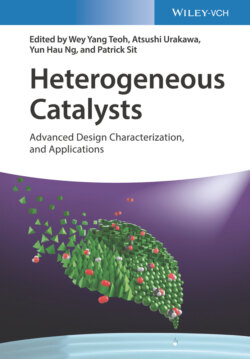Читать книгу Heterogeneous Catalysts - Группа авторов - Страница 44
4.1 Introduction
ОглавлениеActivated carbon is typically the choice of industry as catalyst supports for noble metals for hydrogenation and oxidation in liquid phase due to its outstanding properties such as resistance to basic/acidic media, chemical inertness, high surface area, and the easy recovery of the noble metals by calcination. Carbon black, consisting of microporous and graphitic carbon, is the benchmark support for noble metals used in electrocatalysis due to its excellent conductivity (see for examples, Chapter 30 for electrocatalytic water splitting, and Chapter 32 for fuel‐cell‐related electrocatalytic reactions). More recently, development of carbon‐based catalysts have been identified as key technology in enabling the future biobased economy due to its resistance to hydrothermal conditions typical of biomass conversion processes (see Chapter 33 for the conversion of lignocellulose to fuel and Chapter 34 for the valorization of carbohydrates) [1]. The inertness of some carbon materials endows them with certain advantages over oxidized supports such as keeping metal nanoparticles in more reduced state compared with other supports [2], low metal–support interaction, and preventing the deactivation by coke deposition. Despite the aforementioned advantages of carbon over other metal oxide supports, the preparation of supported catalysts on carbon is more challenging than on metal oxide supports due to the complex surface chemistry of the former. Owing to their rich surface chemistry, variations of carbon‐based materials can be designed as metal‐free catalysts. There are excellent tutorials and reviews about the preparation and use of carbon‐based materials as metal‐free catalysts or “carbocatalysts” [3, 4]. Therefore, this chapter does not cover the preparation of carbocatalysts and instead focuses on the design and preparation of metal catalysts supported on carbon.
Supported catalysts on carbon have been commonly prepared based on the adsorption of metal precursor on carbon surface via equilibrium adsorption, incipient wetness impregnation, or dry impregnation. The adsorption of the precursor takes place on the oxygenated surface groups or within micropores. The latter one takes place due to the high adsorption potential of the pore walls in confined spaces. The process needs a subsequent reduction of the metal precursor either by thermal treatment in H2 gas or using a reductant in liquid phase (hydrazine, sodium borohydride, formaldehyde, etc.). However, these methods impart limited control over the particle size and interparticle distance. Recently, the interparticle distance has been confirmed as a key factor for the selectivity of certain reactions, and it is also crucial to prevent sintering [5]. New emerging techniques have been receiving intense interest for the preparation of single‐site catalysts or metal clusters of defined particle size and interparticle distance. Single‐atom metal catalysts (SACs) with full utilization of the metal centers have the potential to bridge the gap between molecular and solid‐state heterogeneous catalysis. While the preparation of stable SACs with high loadings on conventional carbon supports is still challenging, the advent of new carbon allotropes is providing better alternative supports for single‐atom catalysts. Section 4.2 deals with these novel carbon materials. The catalyst design involves the optimization of not only the catalytic performance, but also the physicochemical properties (surface area, acidity) and mechanical properties (strength, attrition, 3D structures) as well as the catalyst distribution within 3D structures. Along with the use of conventional techniques for the preparation of SACs or nanoclusters on novel carbon materials, new techniques are emerging as a result of new technical developments as described in Section 4.3.
